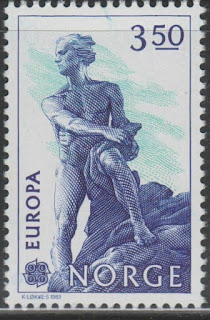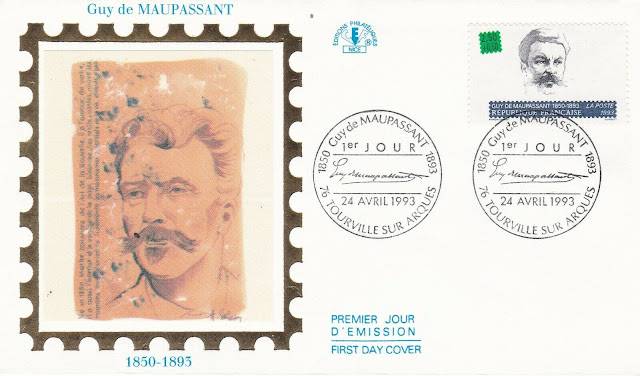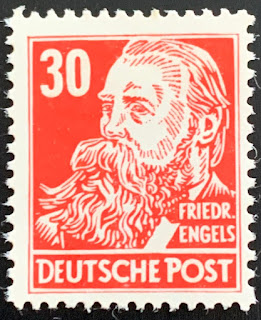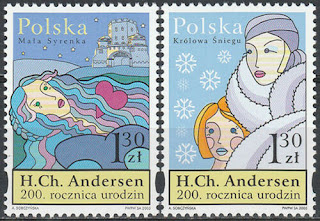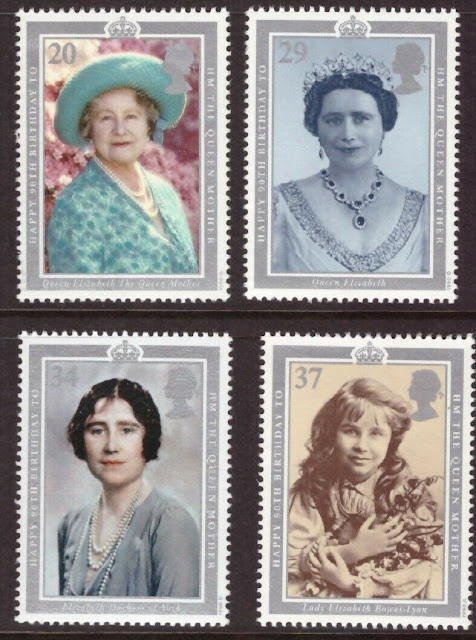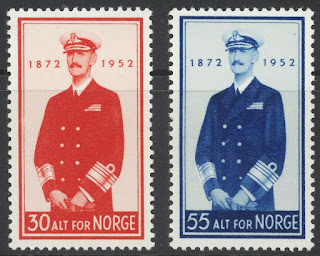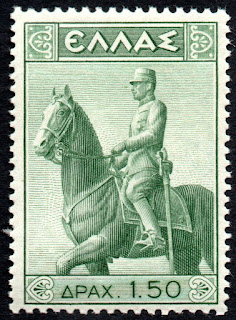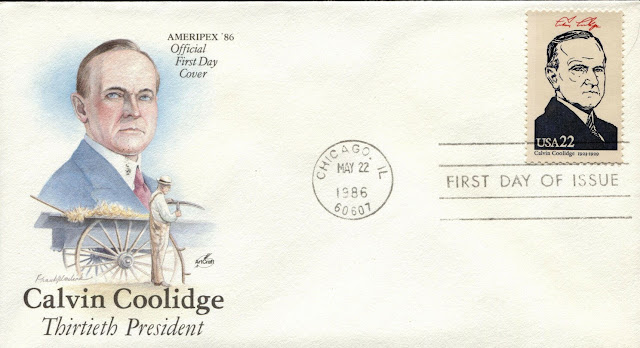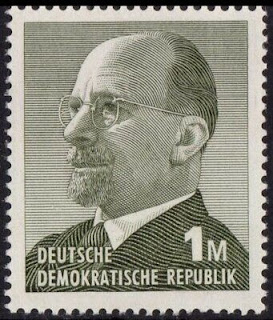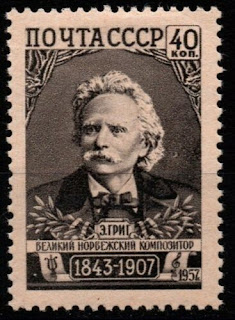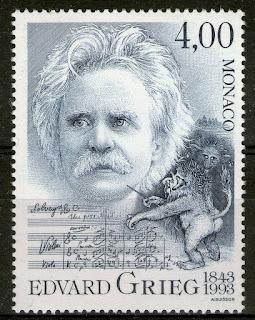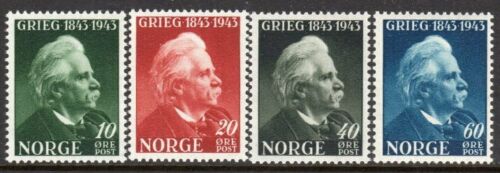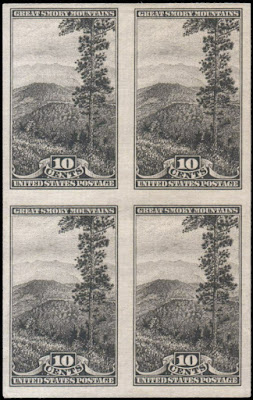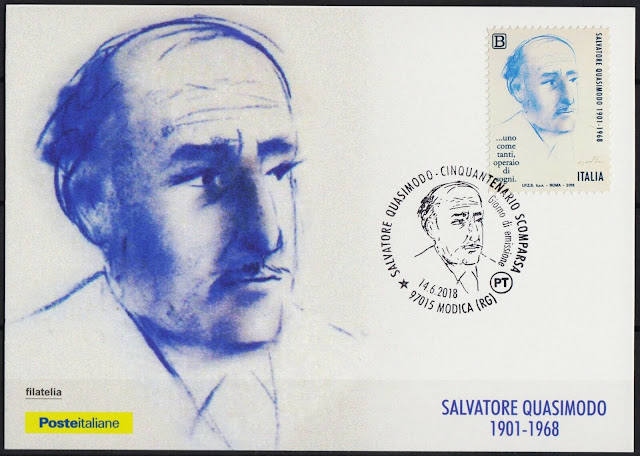Wednesday, August 05, 2020
August 5th in stamps Niels Henrik Abel, Guy de Maupassant, Friedrich Engels
Tuesday, August 04, 2020
August 4th in stamps Hans Christian Andersen, Queen Elizabeth The Queen Mother, Marilyn Monroe
Andersen's fairy tales, consisting of 3381 works and translated into more than 125 languages, have become culturally embedded in the West's collective consciousness, readily accessible to children, but presenting lessons of virtue and resilience in the face of adversity for mature readers as well. His most famous fairy tales include "The Emperor's New Clothes," "The Little Mermaid," "The Nightingale," "The Steadfast Tin Soldier", "The Red Shoes", "The Princess and the Pea," "The Snow Queen," "The Ugly Duckling," "The Little Match Girl," and "Thumbelina." His stories have inspired ballets, plays, and animated and live-action films. One of Copenhagen's widest and busiest boulevards, skirting Copenhagen City Hall Square at the corner of which Andersen's larger-than-life bronze statue sits, is named "H.C. Andersens Boulevard."
Stamps from Denmark, Poland and Germany depicting Hans Christian Andersen or his works
Monday, August 03, 2020
August 3rd in stamps Ivan Zajc, Haakon VII, Solzhenitsyn
Sunday, August 02, 2020
August 2nd in stamps signing of the United States Declaration of Independence, Constantine I, Calvin Coolidge
His disagreement with Eleftherios Venizelos over whether Greece should enter World War I led to the National Schism. Constantine forced Venizelos to resign twice, but in 1917 he left Greece, after threats by the Entente forces to bombard Athens; his second son, Alexander, became king. After Alexander's death, Venizelos' defeat in the 1920 legislative elections, and a plebiscite in favor of his return, Constantine was reinstated. He abdicated the throne for the second and last time in 1922, when Greece lost the Greco-Turkish War of 1919–1922, and was succeeded by his eldest son, George II. Constantine died in exile four months later, in Sicily.
Greek stamps depicting Constantine I
Coolidge restored public confidence in the White House after the scandals of his predecessor's administration, and left office with considerable popularity. As a Coolidge biographer wrote: "He embodied the spirit and hopes of the middle class, could interpret their longings and express their opinions. That he did represent the genius of the average is the most convincing proof of his strength".
Scholars have ranked Coolidge in the lower half of those presidents that they have assessed. He is praised by advocates of smaller government and laissez-faire economics, while supporters of an active central government generally view him less favorably, though most praise his stalwart support of racial equality.
US stamps depicting Coolidge
Saturday, August 01, 2020
August 1st in stamps Colorado, 1936 Olympics, Richard Kuhn, Bazil Assan, Walter Ulbricht
1973 Died: Walter Ulbricht, German soldier and politician (b. 1893)
Walter Ernst Paul Ulbricht (June 1893 – 1 August 1973) was a German communist politician. Ulbricht played a leading role in the creation of the Weimar-era Communist Party of Germany (KPD) and later (after spending the years of Nazi rule in exile in France and the Soviet Union) in the early development and establishment of the German Democratic Republic in East Germany. As the First Secretary of the Socialist Unity Party from 1950 to 1971, he was the chief decision-maker in East Germany. From President Wilhelm Pieck's death in 1960 on, he was also the East German head of state until his own death in 1973. As the firm leader of the strongest and most important Communist satellite, Ulbricht had a degree of bargaining power with the Kremlin that he used effectively. For example he demanded the building of the Berlin Wall in 1961 when the Kremlin was reluctant.
Ulbricht began his political life during the German Empire, when he joined first the Social Democratic Party of Germany (SPD) in 1912, the anti-World War I Independent Social Democratic Party of Germany (USPD) in 1917 and deserted the Imperial German Army in 1918. He joined the Communist Party of Germany in 1920 and became a leading party functionary, serving in its Central Committee from 1923 onward. After the Nazi takeover of Germany in 1933, Ulbricht lived in Paris and Prague from 1933 to 1937 and in the Soviet Union from 1937 to 1945.
After the end of World War II, Ulbricht re-organized the German Communist Party in the Soviet occupation zone along Stalinist lines. He played a key role in the forcible merger of the KPD and SPD into the Socialist Unity Party of Germany (SED) in 1946. He became the First Secretary of the SED and effective leader of the recently established East Germany in 1950. The Soviet Army occupation force violently suppressed the uprising of 1953 in East Germany on 17 June 1953, while Ulbricht hid in the Soviet Army headquarters in Berlin-Karlshorst. East Germany joined the Soviet-controlled Warsaw Pact upon its founding in 1955. Ulbricht presided over the total suppression of civil and political rights in the East German state, which functioned as a communist-ruled dictatorship from its founding in 1949 onward.
The nationalization of East German industry under Ulbricht failed to raise the standard of living to a level comparable to that of West Germany. The result was massive emigration, with hundreds of thousands of people fleeing the country to the west every year in the 1950s. When Soviet Premier Nikita Khrushchev gave permission for a wall to stop the outflow in Berlin, Ulbricht had the Berlin Wall built in 1961, which triggered a diplomatic crisis and succeeded in curtailing emigration. The failures of Ulbricht's New Economic System and Economic System of Socialism from 1963 to 1970 led to his forcible retirement for "health reasons" and replacement as First Secretary in 1971 by Erich Honecker with Soviet approval. Ulbricht suffered a stroke and died in 1973.
East German stamps depicting Walter Ulbricht
Monday, June 15, 2020
June 15th in stamps Edvard Grieg, Kaiser Wilhelm II, Great Smoky Mountains National Park
The eldest grandchild of Queen Victoria, Wilhelm's first cousins included King George V of the United Kingdom and many princesses who, along with Wilhelm's sister Sophia, became European consorts. For most of his life before becoming emperor, he was second in line to succeed his grandfather Wilhelm I on the German and Prussian thrones after his father, Crown Prince Frederick. His grandfather and father both died in 1888, the Year of Three Emperors, making Wilhelm emperor and king. He dismissed the country's longtime chancellor, Otto von Bismarck, in 1890.
Upon consolidating power as emperor, Wilhelm launched Germany on a bellicose "New Course" to cement its status as a respected world power. However, he frequently undermined this aim by making tactless, alarming public statements without consulting his ministers. He also did much to alienate his country from the other Great Powers by initiating a massive build-up of the German Navy, challenging French control over Morocco, and backing the Austrian annexation of Bosnia in 1908. His turbulent reign ultimately culminated in his guarantee of military support to Austria-Hungary during the crisis of July 1914, resulting in the outbreak of World War I. A lax wartime leader, he left virtually all decision-making regarding military strategy and organisation of the war effort in the hands of the German General Staff. This broad delegation of authority gave rise to a de facto military dictatorship whose belligerent foreign policy led to the United States' entry into the war on April 6, 1917. After losing the support of the German military and his subjects in November 1918, Wilhelm abdicated and fled to exile in the Netherlands, where he died in 1941.
Stamp issued by Germany depicting Wilhelm II
Postcard depicting Wilhelm II
Sunday, June 14, 2020
June 14th in stamps Karl Landsteiner, Max Weber, Ernesto "Che" Guevara, Salvatore Quasimodo
Saturday, June 13, 2020
June 13th in stamps Egbert Bartholomeusz Kortenaer, Heinrich Hoffmann, Ludwig II, king of Bavaria
1665 Died: Egbert Bartholomeusz Kortenaer, Dutch admiral (b. 1604)
Egbert Bartholomeuszoon Kortenaer or Egbert Meussen Cortenaer (1604 – 13 June 1665) was an admiral of the United Provinces of the Netherlands who was killed in the Battle of Lowestoft.
Kortenaer was born in 1604 in Groningen of humble origins. In 1626, he was made boatswain, in 1636, second mate. In the First Anglo-Dutch War, he served as first mate in 1652 on the Dutch flagship, Brederode. In the Battle of Dungeness, he lost his right hand and eye. On 10 April 1653, he was made commandeur to replace flag captain Abel Roelants when Lieutenant-Admiral Maarten Tromp used Brederode as his flagship. In the Battle of Scheveningen, Tromp was killed. Kortenaer kept Tromp's standard raised to keep up morale (this was habitual for the Dutch on such occasions) and took command of his squadron. On 21 October 1653, Kortenaer was promoted to captain. In the years after the war, he often commanded squadrons as commodore when flag officers were absent.
In the Battle of the Sound (8 November 1658), serving as flag captain on Eendragt, he beat off every Swedish attack while his commanding officer, Lieutenant-Admiral Jacob van Wassenaer Obdam, was debilitated by gout. After this heroic conduct against the Swedish, Kortenaer was promoted to vice-admiral on 8 May 1659 and knighted by Frederick III of Denmark in the Order of the Elephant. On 29 January 1665, shortly before the Second Anglo-Dutch War, he was made lieutenant-admiral of the Admiralty of de Maze. He wasn't given command of the confederate Dutch fleet because he was a supporter of the House of Orange. A British intelligence report stated, "He is the best man they have".
During the Battle of Lowestoft on 13 June 1665, Kortenaer commanded the van and was second in overall command behind Van Wassenaer. He was fatally wounded early in the battle on Groot Hollandia by a cannonball hitting his hip and buried in Rotterdam in a marble grave memorial engraved with a poem by Gerard Brandt:
The Hero of the Maas, bereft of eye
and his right hand
Yet of the Wheel the Eye, Fist of
the Fatherland
KORTENAER the Great, the terror
of foe's fleets
the forcer of the Sound by this grave
his country greets
Stamps from Sint Maarten depicting Egbert Bartholomeuszoon Kortenaer
Heinrich Hoffmann (June 13, 1809 – September 20, 1894) was a German psychiatrist, who also wrote some short works including Der Struwwelpeter, an illustrated book portraying children misbehaving.
Hoffmann published poems and a satirical comedy before, in 1845, a publisher friend persuaded him to have a collection of illustrated children's verses printed which Hoffmann had done as Christmas present for his son. The book, later called Struwwelpeter after one of its anti-heroes, became popular with the public and had to be reprinted regularly; many foreign translations followed. "Struwwelpeter" was not perceived as cruel or overly moral by Hoffmann's contemporaries. The original title, "Funny stories and droll pictures", indicates that entertainment was at least partly the author's intention.
After the book's success, Hoffmann felt persuaded to write other children's books, of which only the first, König Nussknacker und der arme Reinhold, became popular.
He also kept on writing satires and (often comic) poems for adults. His satires show his strong skepticism towards all kinds of ideology and his distaste for religious, philosophical, or political bigotry. Even in Germany, he is today largely remembered for his Struwwelpeter.
Hoffmann was a man of liberal sympathies, campaigned for the goal of a constitutional monarchy, participated in the Vorparlament, and joined the Freemasons but later left due to their refusal to admit Jews.
German stamps depicting characters created by Heinrich Hoffmann
1886 Died: Ludwig II, king of Bavaria (b. 1845)
Ludwig II (German: Ludwig Otto Friedrich Wilhelm; English: Louis Otto Frederick William; 25 August 1845 – 13 June 1886) was King of Bavaria from 1864 until his death in 1886. He is sometimes called the Swan King or der Märchenkönig ("the Fairy Tale King"). He also held the titles of Count Palatine of the Rhine, Duke of Bavaria, Duke of Franconia, and Duke in Swabia.
Ludwig succeeded to the throne in 1864, aged 18. Two years later, Bavaria and Austria fought a war against Prussia lasting only a matter of weeks, which they lost. However, in the Franco-Prussian War of 1870, Bavaria sided with Prussia against France, and after the Prussian victory, it became part of the new German Empire led by Prussia. Though Bavaria retained a degree of autonomy on some matters within the new German Reich, Ludwig increasingly withdrew from day-to-day affairs of state in favour of extravagant artistic and architectural projects. He commissioned the construction of two lavish palaces and Neuschwanstein Castle, and he was a devoted patron of the composer Richard Wagner. Ludwig spent all his royal revenues (although not state funds as is commonly thought) on these projects, borrowed extensively, and defied all attempts by his ministers to restrain him. This extravagance was used against him to declare him insane, an accusation that has since come under scrutiny. Today, his architectural and artistic legacy includes many of Bavaria's most important tourist attractions.
German stamp depicting King Ludwig II of Bavaria
